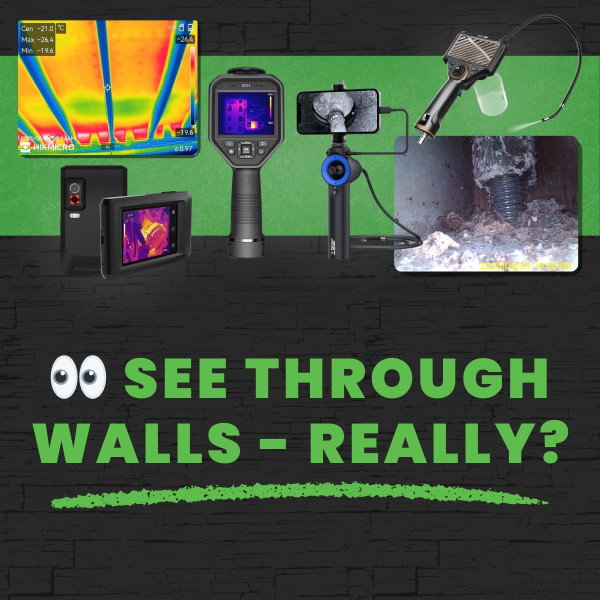How to Detect Water Leaks with Infrared & Borescopes
In restoration, construction, and facility maintenance, hidden damage is one of the biggest challenges. Water seeping behind walls, smoke residue lingering in ducting, mould forming in cavities — all of these can be invisible to the naked eye but devastating to building integrity and health.
Traditional inspections often involve guesswork and invasive demolition. Today, advanced diagnostic tools like Hikmicro infrared cameras and JEET videoscopes / borescopes allow professionals to see further, work smarter, and document findings with precision — all while minimising disruption.
The Challenge: Finding Problems Before They Escalate
Whether it’s tracing water ingress, checking fire damage, or locating electrical faults, restoration specialists face two major issues:
- Hidden contamination – Moisture or hidden leaks, mould, and soot often spread where you can’t see them.
- Client expectations – Insurance assessors and property owners demand proof of damage and remediation, not guesswork.
The solution: Combine thermal imaging and visual inspection to locate and confirm issues before taking action. This is the modern, non-invasive way to detect problems early, prevent secondary damage, and meet the growing demand for clear evidence.
Why Water Leak Detection Matters
- Prevents mould outbreaks by catching moisture before spores spread.
- Protects structural integrity of walls, ceilings, and flooring.
- Reduces unnecessary demolition by pinpointing exact problem areas.
- Improves insurance claims with clear, documented evidence.
What Is an Infrared Camera?
An infrared thermal camera detects heat instead of visible light. Every object emits infrared radiation depending on its temperature. The camera senses these differences and creates a thermal image where cooler and warmer areas are highlighted in different colours.
How it works in restoration:
- Moisture evaporates and cools materials.
- Infrared cameras detect the temperature drop, revealing hidden leaks as “cold spots.”
- The result: fast, non-destructive scanning of walls, ceilings, and floors.
Hikmicro Thermal Cameras at Restore Solutions
| Model | Key Features | Best Use Case |
|---|---|---|
| Pocket2 | Compact 256×192 resolution, 8MP visual camera, Wi-Fi sharing | Fast inspections and mobile leak detection |
| M11 | Entry-level handheld, 192×144 resolution, simple controls | Affordable option for basic scanning |
| M20 | 256×192 resolution, 3.5″ LCD, rugged design | Everyday building diagnostics and moisture surveys |
| M31 | Upgraded clarity, larger screen, multiple imaging modes | Versatile choice for mid-level professionals |
| M60 | 640×480 resolution, SuperIR image enhancement, advanced reporting | High-resolution inspections and insurance reporting |
This snapshot of models available provides solutions for all levels of restoration work:
- Pocket2 and M11 for fast, accessible leak detection.
- M20 and M31 for reliable, mid-range diagnostics.
- M60 for premium clarity and professional-grade reporting.
What Is a Borescope or Videoscope?
A borescope is a slim inspection tool with a camera or lens and light at the tip, designed to look inside cavities through a small entry point. A videoscope is a more advanced version, offering higher resolution, articulation, and recording functions for documentation.
How they work in restoration:
- Drill a small, repairable hole (6–10 mm).
- Insert the probe to visually inspect hidden cavities.
- Capture live video or still images of leaks, mould, corrosion, or fire residue.
Jeet Borescopes and Videoscopes at Restore Solutions
| Model | Key Features | Best Use Case |
|---|---|---|
| S610 | 360° joystick control, 220° probe bend, 1MP imaging, tungsten braided probe | Reliable cavity inspections for restoration jobs |
| QT360 | Smartphone-compatible, 360° articulation, HD video, Wi-Fi reporting | Portable inspections with mobile sharing |
| Ptool Series | Compact, budget-friendly inspection cameras | Entry-level inspections and tight-space access |
| T35H | Industrial-grade probe, high-definition imaging, rugged build | Heavy-duty inspections in tough environments |
| T51X | Advanced videoscope with extended probe length, HD recording | Large-scale inspections and deep cavity access |
This range ensures there is a JEET solution for every job:
- Ptool and QT360 for quick, accessible inspections.
- S610 for routine, professional restoration checks.
- T35H and T51X for more demanding environments and deeper inspections.
Why Use Both Infrared Cameras and Borescopes?
These tools are strongest when used together:
- Infrared Camera = Find It
Quickly scan large areas for temperature anomalies. - Borescope/Videoscope = See It
Confirm what’s really happening inside walls, ceilings, or floors. - Moisture Meter = Prove It
Quantify water content for evidence-based reporting.
This scan–inspect–verify workflow sets the benchmark for modern restoration.
Pro Tips on How to Detect Water Leaks in Walls
- Use thermal cameras in stable environments (avoid direct sunlight or drafts).
- Place borescope entry points discreetly (behind skirting boards, inside cupboards).
- Always confirm findings with calibrated moisture meters.
- Keep equipment calibrated and maintained for accuracy.
- Document with images, thermal scans, and readings for insurer-ready reports.
FAQs
Can a thermal camera detect water directly?
No. It detects the cooling effect of moisture, not the water itself.
Do I still need moisture meters?
Yes. Thermal and visual inspection shows potential problems, but moisture meters provide the numerical data insurers require.
How small of a leak can thermal cameras detect?
Professional-grade cameras like the Hikmicro range can detect very subtle temperature anomalies, allowing you to identify even small leaks before visible damage occurs.
Do thermal cameras work on all building materials?
They are most effective on materials like plasterboard and roofing. Shiny or reflective surfaces (like metal) may distort readings, so combining with borescopes and moisture meters is essential.
Do I need to drill holes to use a borescope?
Usually, yes. A small 6–10 mm hole is required, but this is far less invasive than cutting out large sections of wall and can be repaired easily.
Are these tools difficult to learn?
No. Most technicians can become proficient quickly. Modern Hikmicro and Jeet models are user-friendly and designed for fast adoption on job sites.
Professional Leak Detection Made Simple
Hidden damage used to mean guesswork and demolition. Today, with Hikmicro thermal cameras and Jeet videoscopes restoration professionals can confidently say:
“I can see through walls.”
By combining thermal imaging and visual inspection, you can detect problems early, minimise disruption, and present insurers and clients with clear, irrefutable evidence.
At Restore Solutions, we stock a wide range of infrared cameras, videoscopes, borescopes, and moisture meters — giving professionals the power to work smarter and restore faster.
Explore our leak detection equipment range today
Recent Posts
-
Ten Years of Restore Solutions: Innovation for Restorers
In 2015, Restore Solutions entered the market with one clear purpose — to help restoration professio …2nd Dec 2025 -
The Ultimate Battery Operated Power Scrubber for Restoration Professionals
Less Elbow Grease, More Results: Meet the Battery-Powered Scrubber That Does the Hard Work for You S …17th Nov 2025 -
Choosing the Right Cleaning Chemicals in Restoration: Work Smarter, Work Safer
Chemical safety isn’t an optional extra in restoration — it’s the foundation of professional, consis …9th Nov 2025




